There’s no denying it, Kruger has A LOT of birds. Kruger National Park in South Africa is one of the largest game reserves in Africa and covers a wide range of habitats. It’s no surprise that Kruger has one of the highest diversity of bird species in Southern Africa.
At least 613 bird species have been documented in the park (according to Avibase) though about 85 of those are considered extremely rare (or accidental) sightings. If you consider that there are only 10,906 accepted bird species in the entire world (according to Cornell Lab’s Birds of the World list), that means nearly 6% of the world’s birds have shown up in Kruger!
*This article may contain affiliate links. We receive a small commission at no extra cost to you.*
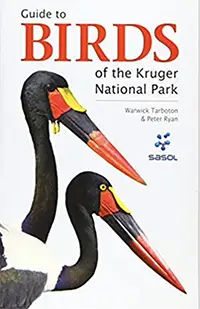
Photographic field guide to birds of the Kruger National Park by Peter Ryan and Warwick Tarboton. Penguin Random House South Africa
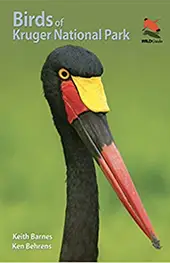
Birds of Kruger National Park by Keith Barnes and Ken Behrens. Published by Princeton University Press
If you are in Kruger to do some birding, head out to the north part of the park. Birding in the north of Kruger is world class and people travel from all over the world to go birdwatching. There are plenty of safari lodges in Kruger where you can relax after a hard day of birding!
Here are some of the birds in Kruger you might find during your next Kruger safari.
Birds of Kruger National Park
Ostrich
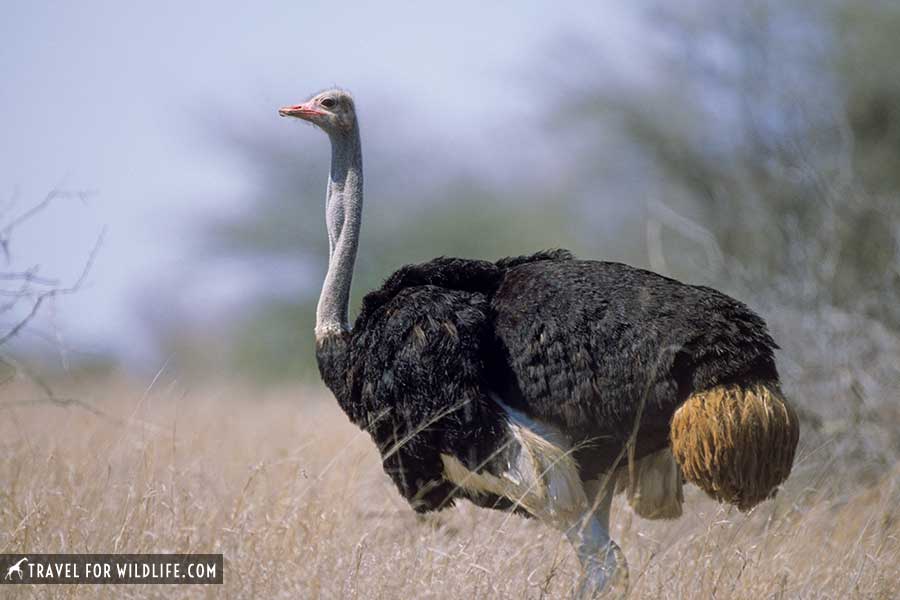
What better way to start the birds of Kruger list than with the largest bird in the world: the ostrich! (Struthio camelus.) They also make the biggest eggs in the world.
These birds are huge, not afraid of the midday heat, and walk around in open areas, so you have a great chance of seeing ostriches at any time in Kruger. It may be about as close as you’ll get to seeing a dinosaur in action.
Francolins and Spurfowl
Francolins and spurfowl are a lot of fun. You’ll often hear them squawking loudly at dawn or dusk long before you see them. But if they’re moving quietly, you’ll have to look carefully to spot these cryptically-colored birds walking amongst the undergrowth (they look sort of like chickens running around). They sometimes become quite tame around rest camps where you can get get a good look at them. There are 12 species of francolins and spurfowls in Kruger (including the blue quail).
Swainson’s spurfowl
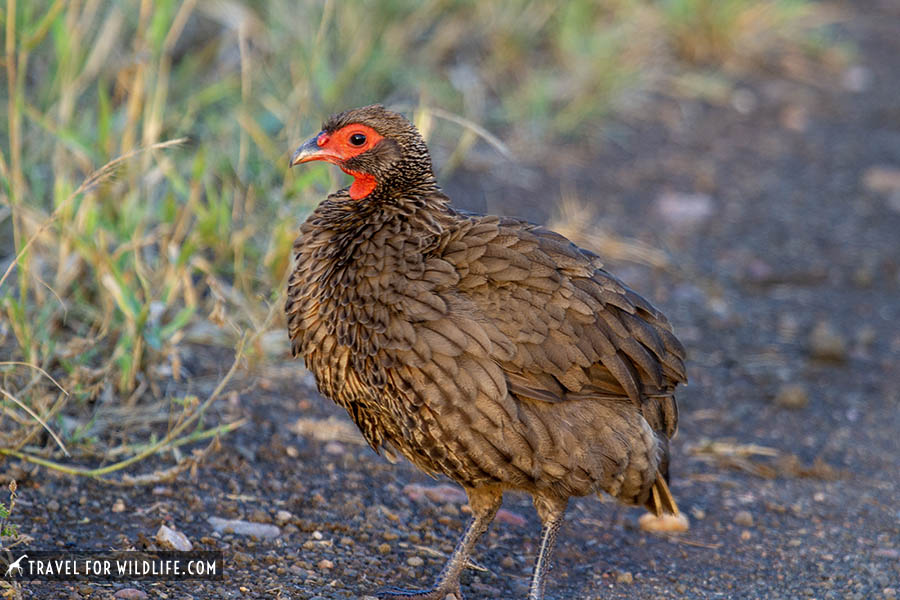
The Swainson’s spurfowl is a common resident in the park and can be seen in pairs or small flocks. They prefer woodland and savanna habitats.
Natal spurfowl
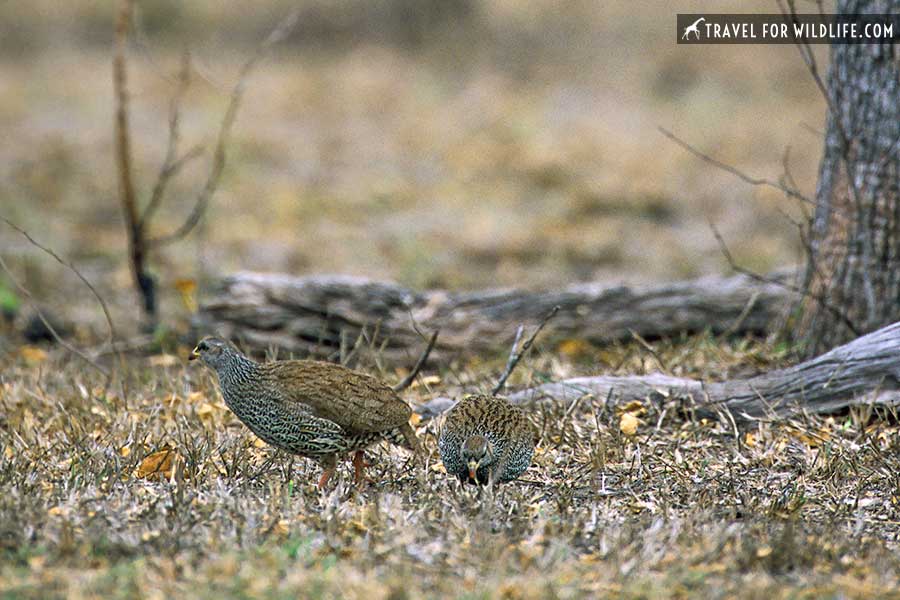
This spurfowl prefers thickets in savanna, woodlands, and at the edge of forests. During winter months they feed on plant matter, while in the summer they supplement their diet with insects.
Ducks and Geese
Kruger has a lot of rivers, dams, and waterholes so you can spot a wide variety of waterfowl. There have been 19 species of ducks and geese documented in the park! Here’s one of our favorites…
African pygmy goose
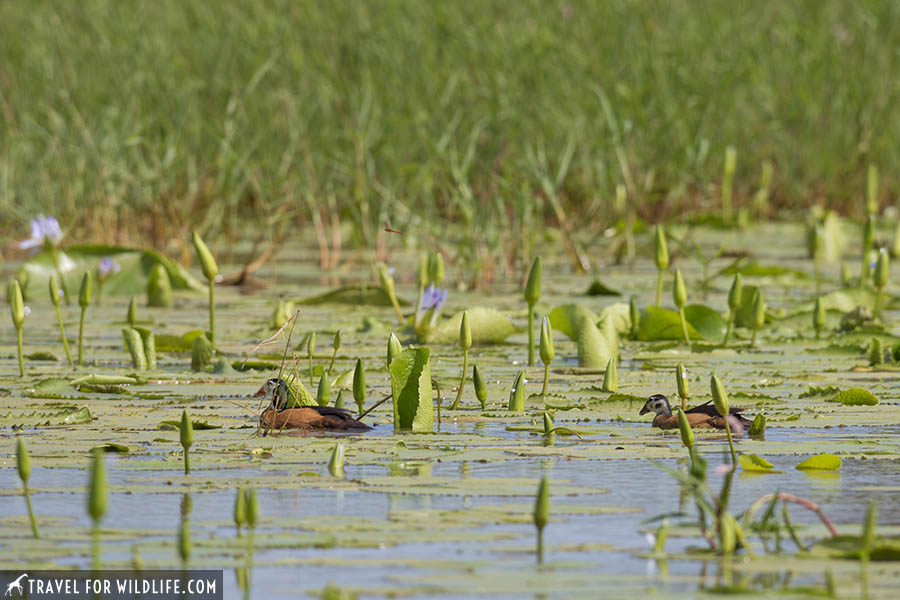
Though it’s called a goose, the African pygmy goose (Nettapus auritus) is more closely related to ducks and is technically termed a “perching duck”. It’s the smallest waterfowl in Africa and one of the smallest in the world! Plus it’s really cute.
Jacanas
While the lesser jacana has appeared in the park, it is considered rare or accidental. The only Jacana you’re likely to see in Kruger is the African jacana…
African Jacana
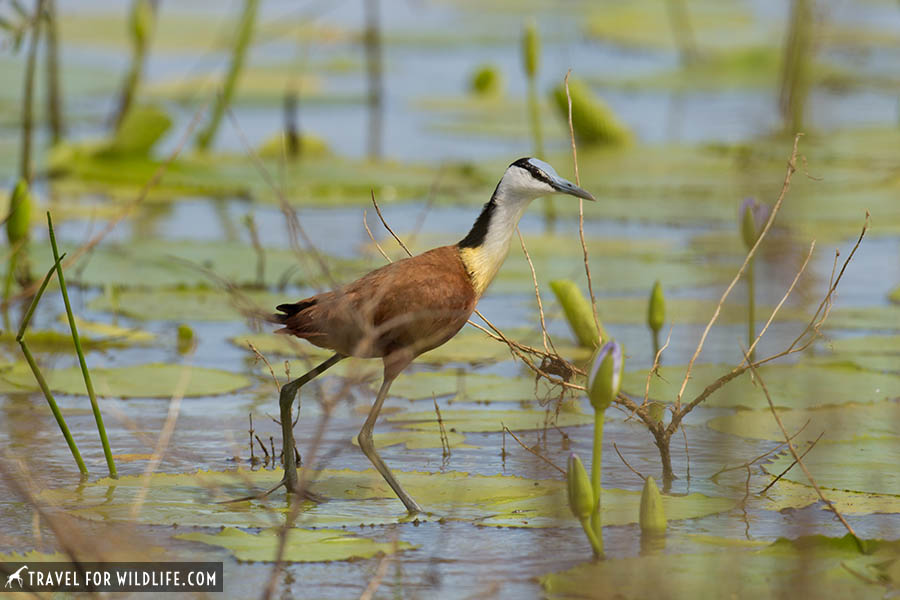
The African jacana (Actophilornis africanus) is instantly recognizable wading across lily pads with its insanely long toes and claws!
Grebes
There are three species of grebes found in Kruger and they’re some of our personal favorites.
Little Grebe
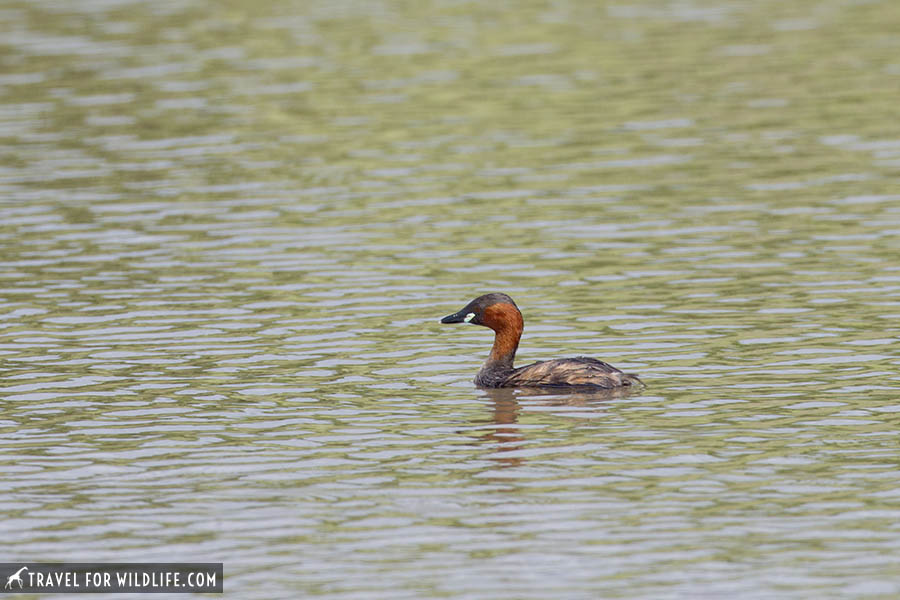
The little grebe (Tachybaptus ruficollis) may look like a small duck but the grebes are not very closely related to ducks at all. Also known as a “dabchick”, the little grebe has a huge range across much of Africa, Europe, and Asia!
Storks
There are 8 species of storks in South Africa and all of them are found in Kruger: White stork, Saddle-billed stork, Woolly-necked stork, Marabou stork, Yellow-billed stork, African open bill, Black stork, and Abdim’s stork. Search for storks in Kruger by looking around aquatic habitats or look for their large nests in trees.
White stork
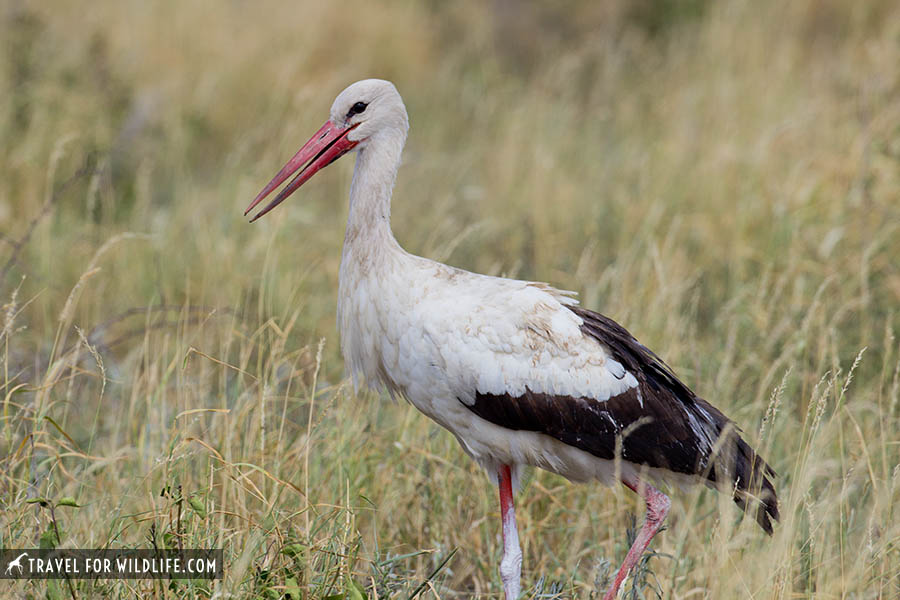
Usually found in flocks of 10-50 birds, the White stork (Ciconia ciconia) is a migrant and is found in the park from October to May. They are insect eaters but will occasionally take mice and small reptiles.
Marabou stork
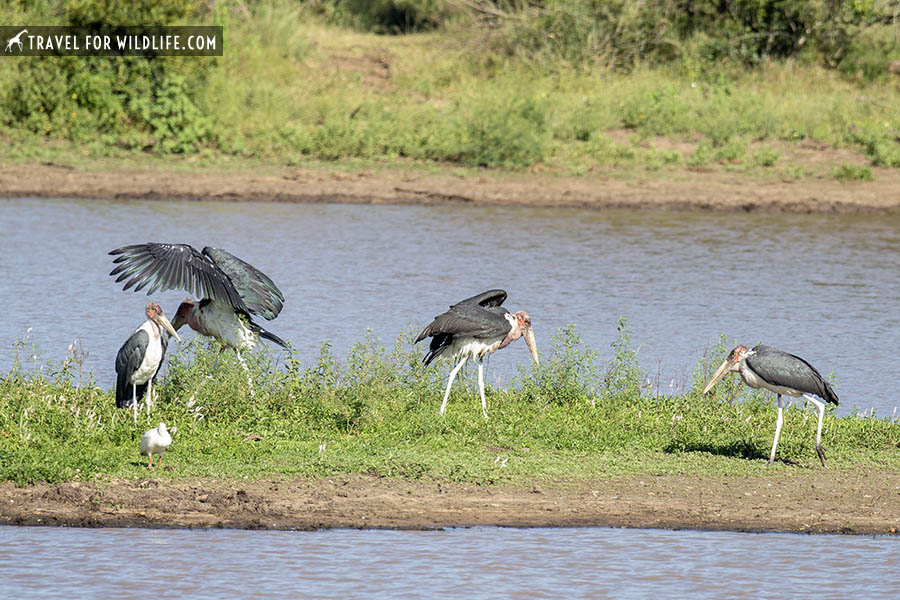
Marabou storks (Leptoptilos crumenifer) are not known for being the prettiest of the stork bunch and their featherless faces might be why. The easiest of the storks to identify because of their pendulous red throat sac and their bulbous orange-red air-sac partly hidden underneath their feathers on their hind neck. Marabou storks are scavengers but sometimes they’ll hunt small mammals or reptiles.
Herons and Egrets
Black-headed heron
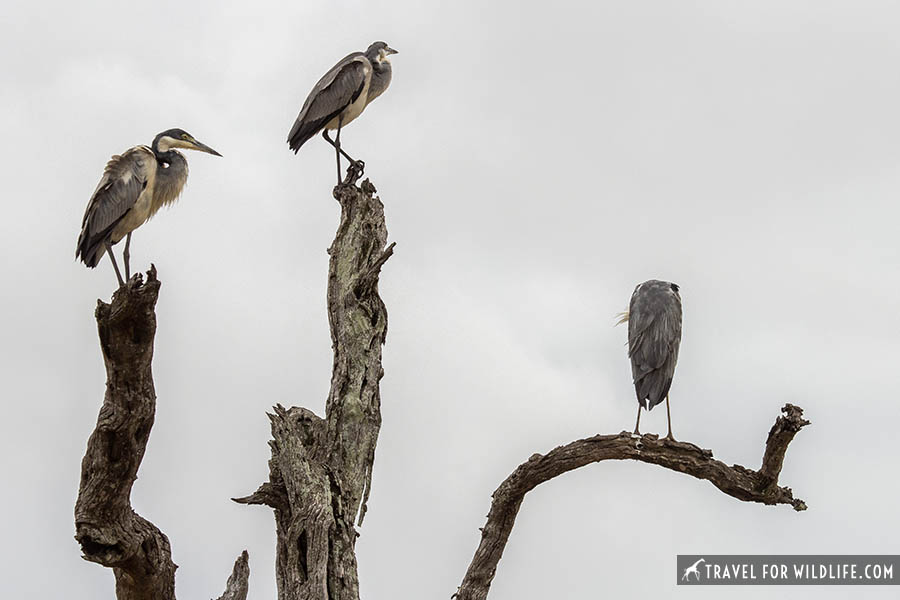
A common resident, the Black-headed heron (Ardea melanocephala) is active both diurnally and nocturnally. Found along the edges of wetlands.
Black-headed herons feed on small reptiles, small mammals, and birds.
Cormorants and Darters
African darter
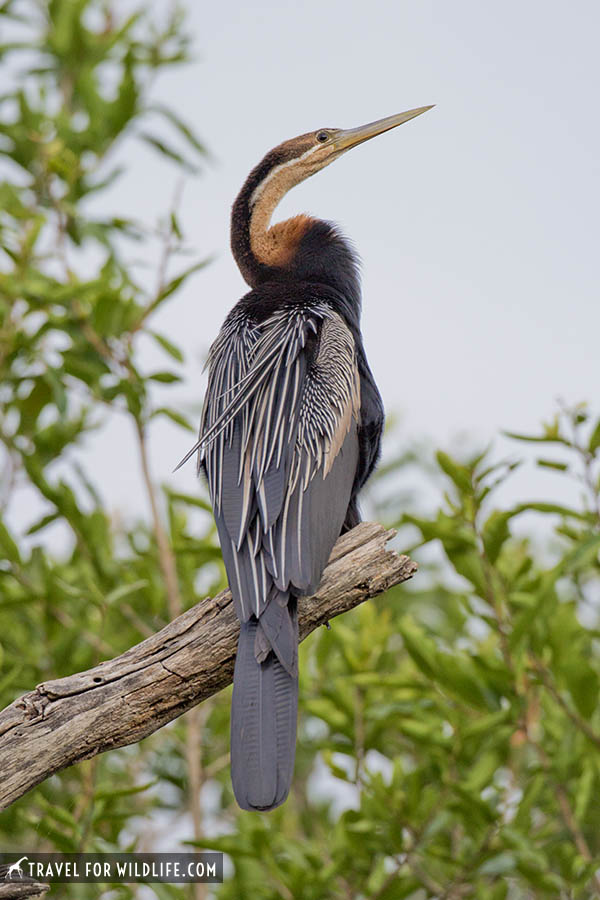
The African darter (Anhinga rufa) is the only bird of the Anhinga genus in South Africa.
Secretary Birds
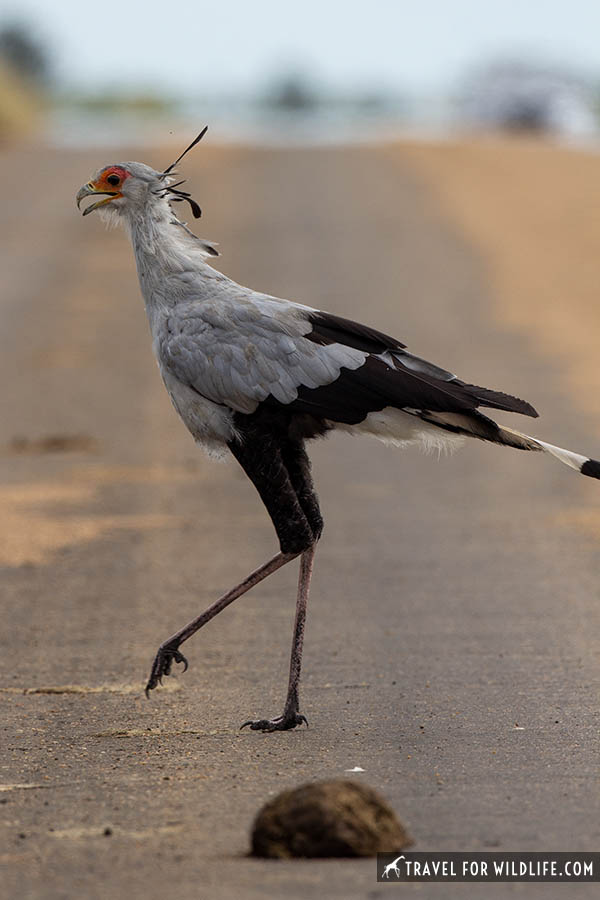
Secretary birds are terrestrial raptors and are always a highlight of our trip if we see one. They hunt for snakes and lizards in grasslands and savannah. This is how they got their scientific name Sagittarius serpentarius.
You can find them in grasslands and open savannah while they hunt. They are normally found alone while they forage.
Check on more secretary bird facts to learn more about these birds.
Lapwings
Lapwings are long-legged plovers found in grassland or along wetlands. They are known to be one of the noisiest birds around.
Blacksmith Lapwing
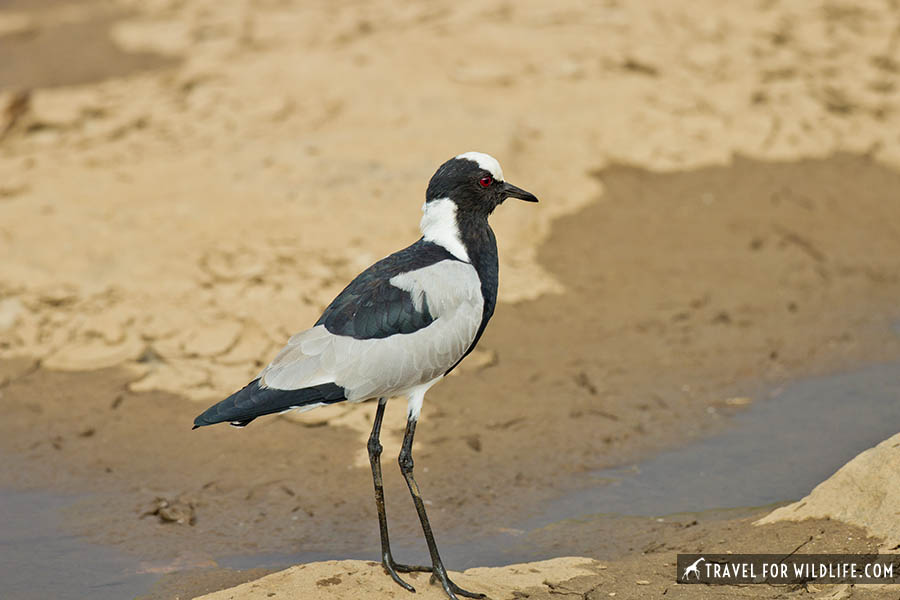
The Blacksmith lapwing gets its name because of its call, as it resembles a blacksmith’s hammer. Found along marshes and wet grasslands they feed on aquatic and terrestrial invertebrates.
Coursers
Temminck’s courser
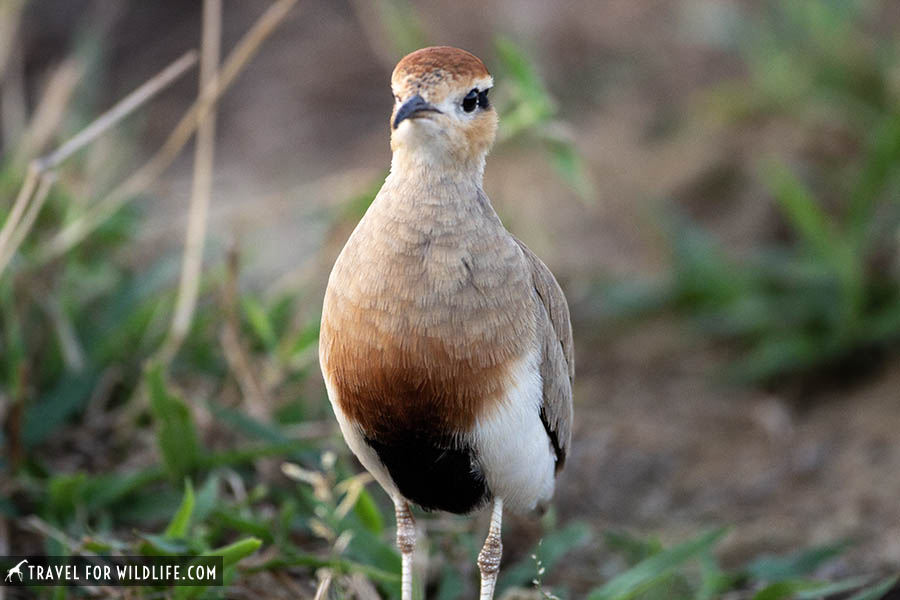
Sandgrouse
Sandgrouse are granivorous birds that can be found either foraging on the ground or around water bodies as they drink regularly. During breeding season and chicks have hatched, males visit waterholes to soak their belly feathers in water to bring to the young.
Double-banded sandgrouse
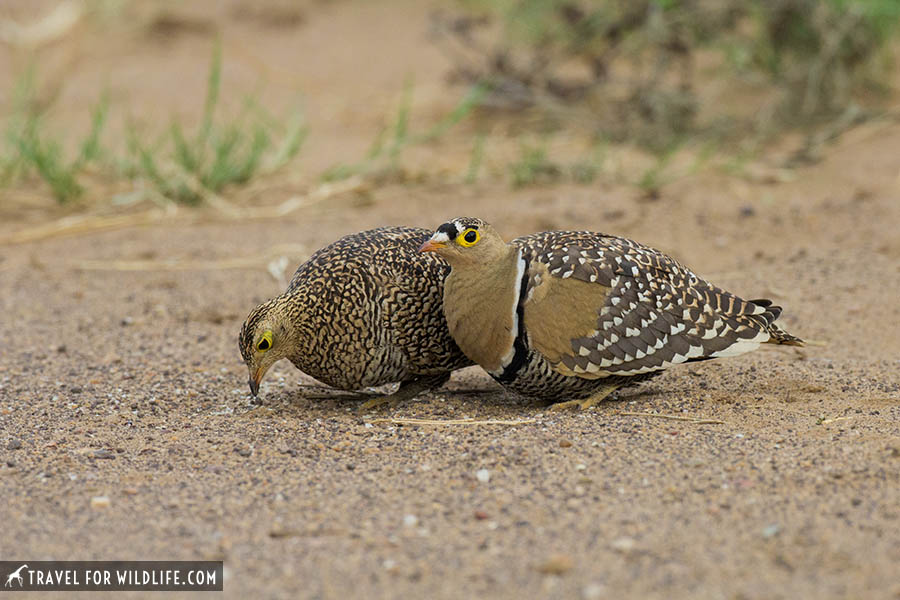
The only species of sandgrouse found in Kruger, the Double-banded sandgrouse’s preferred habitat is the savanna and Mopane woodland. Granivorous, prefers the seeds of leguminous trees and shrubs.
The male has a black and white breast band while the female’s body is barred.
Doves and Pigeons
African mourning collared dove
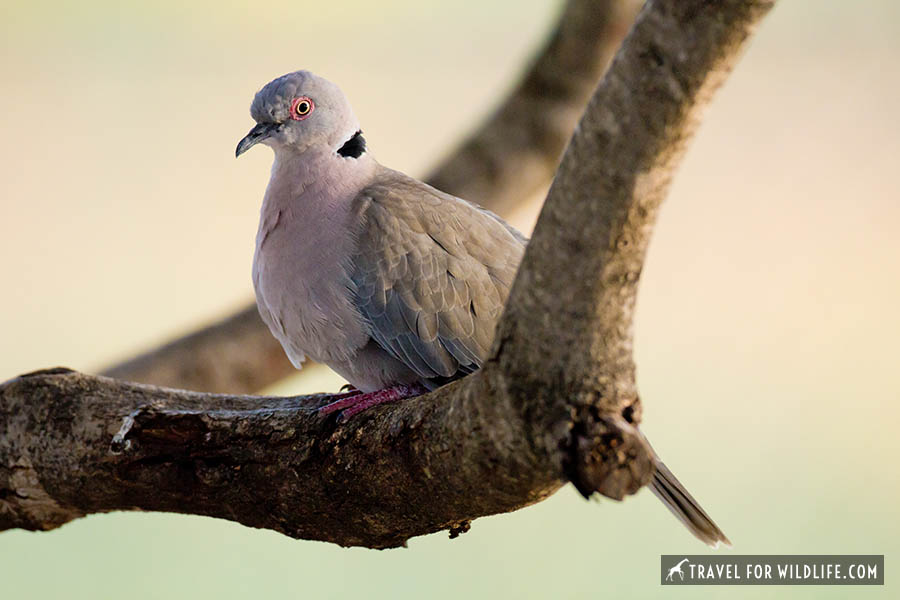
Namaqua dove
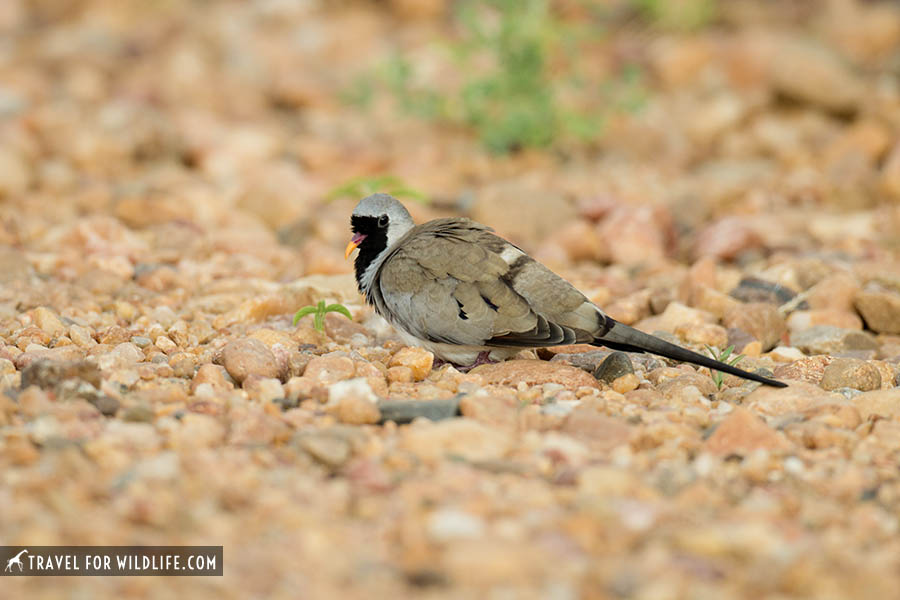
Owls
There are 12 species of owls in South Africa, and you can find ALL these species in Kruger. So, if you are on an owl quest, Kruger is the place to be.
The best way to see owls in Kruger is by joining night game drives, and also by walking quietly around your rest camp at night.
African scops owl
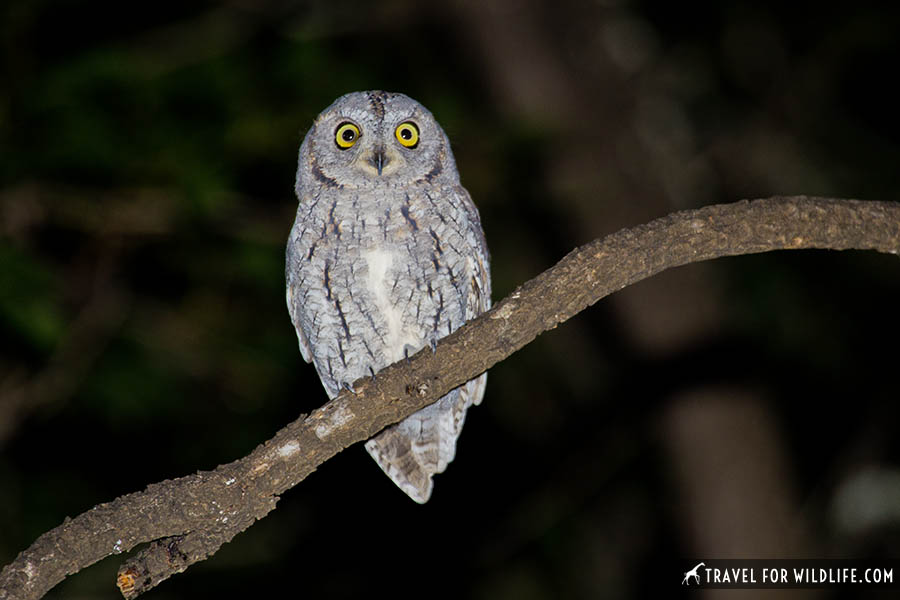
The African scops owl (Otus senegalensis) is the smallest owl in Southern Africa. It has small ear tufts that they can sometimes lay flat.
You can see the African scops owl during evening drives in Kruger or if you are lucky, they’ll be hanging out on a tree at your campsite. We spotted the owl in the photo while camping at Letaba restcamp.
Pel’s Fishing owl
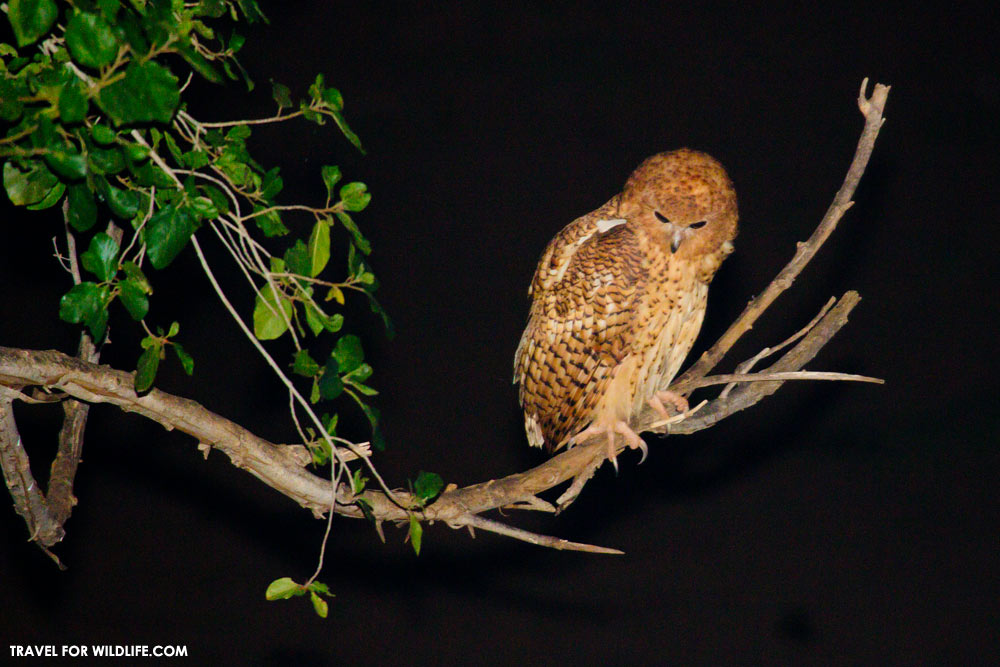
The Pel’s Fishing owl (Scotopelia peli) is on every birder’s list when they visit Kruger and are not easy to spot.
They are the second largest owl in Southern Africa and they feed almost exclusively on fish.
We came across this Pel’s Fishing owl during a night drive while we were staying at The Outpost Lodge. This owl was perched on a branch above the Luvuvhu River while hunting for fish.
Rollers
Lilac-breasted Roller
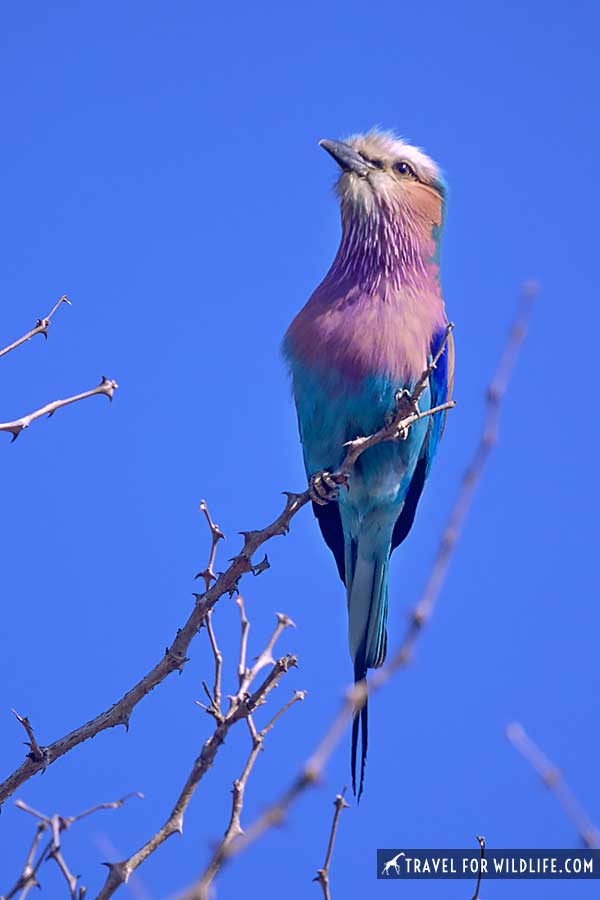
European Roller
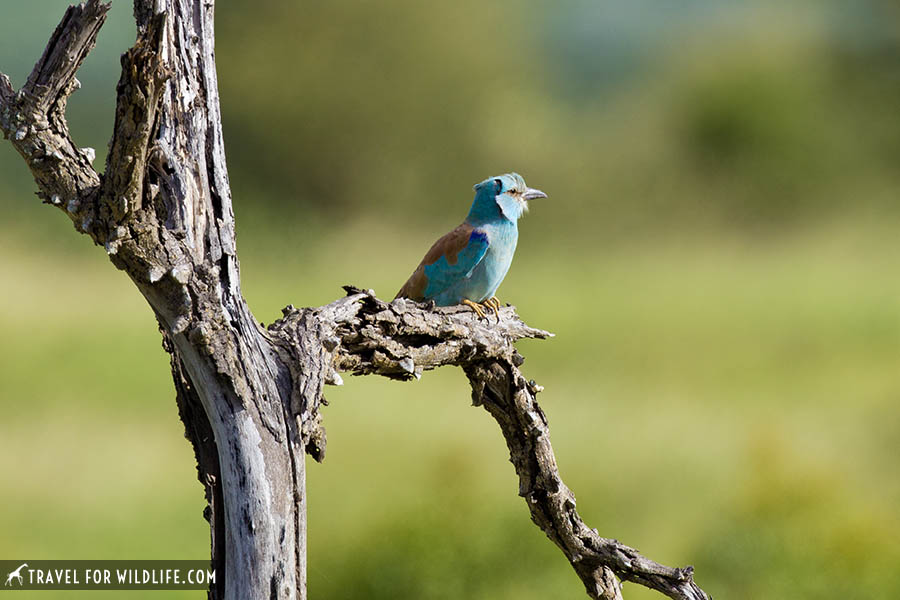
Purple Roller
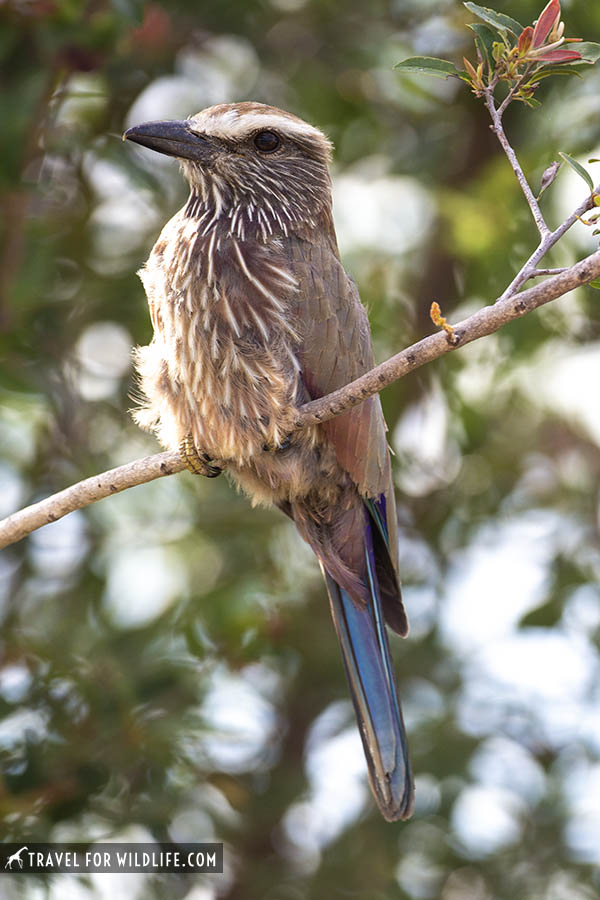
Kingfishers
A few species of kingfishers are found in the park. Scope the riverbanks during the breeding season as some species nest in excavated tunnels.
Not all kingfishers eat fish! For example, the Woodland kingfishers feed on insects, frogs, and small birds!
Giant kingfisher
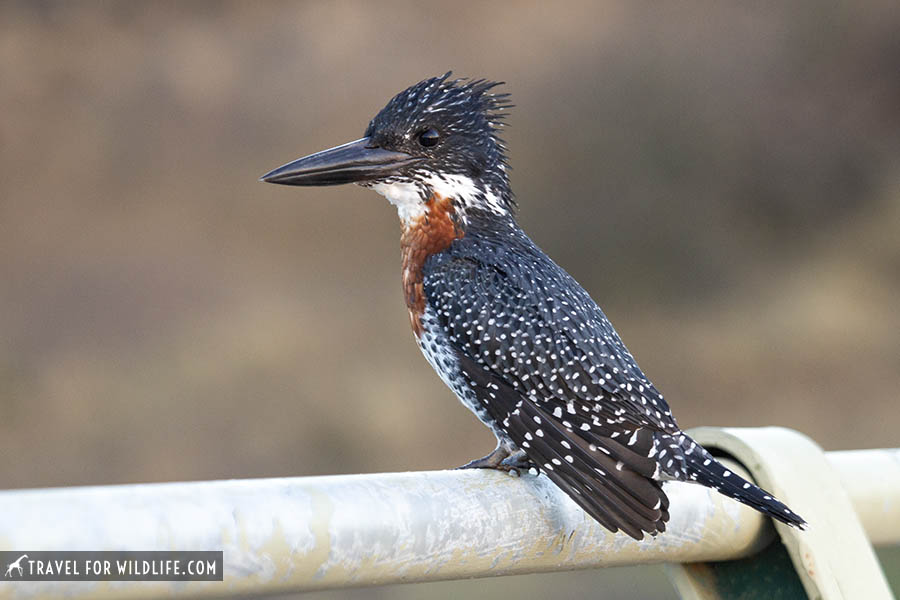
The largest of the kingfishers, the Giant kingfisher is a common resident at altitudes higher than 1,500m. You can tell females from males by looking at their breasts. Females have mottled breasts, while males have rufous colored breasts (like the one in the photo). Females have a rufous belly, while males have a mottled belly.
The Giant kingfisher feeds on mainly fish, but also hunts for crabs, frogs, and aquatic invertebrates.
Woodland Kingfisher
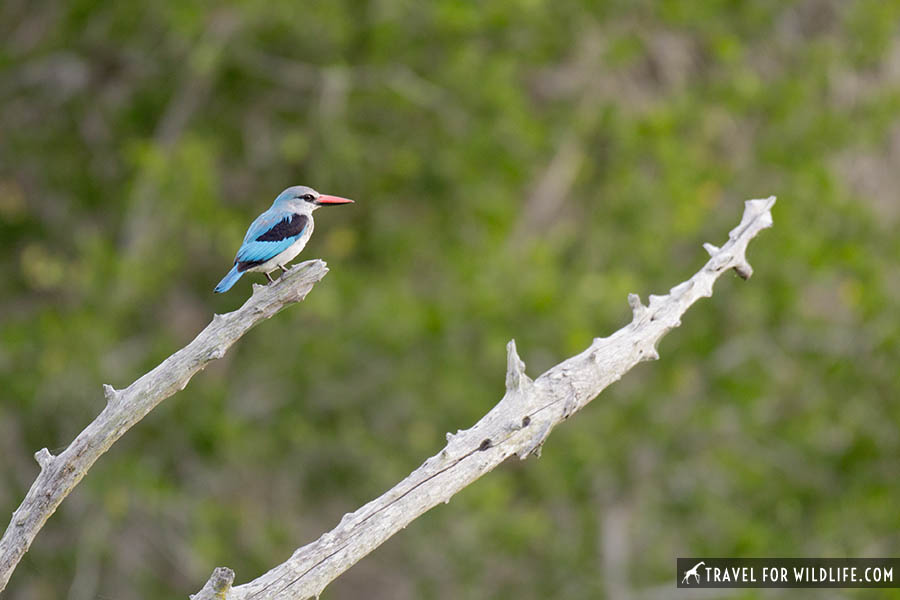
The Woodland kingfisher is a migrant and is only found in Kruger from October to April. They feed on insects, small snakes, frogs, and small birds.
Bee-eaters
Bee-eaters are one of the most colorful birds you’ll come across in Kruger. In chilly winter mornings, you can find small groups of them lined on a branch while keeping each other warm and soaking up the warming rays of sunrise.
Bee-eaters feed on bees and wasps and their nests are excavated tunnels in riverbanks and quarries.
Southern Carmine bee-eater
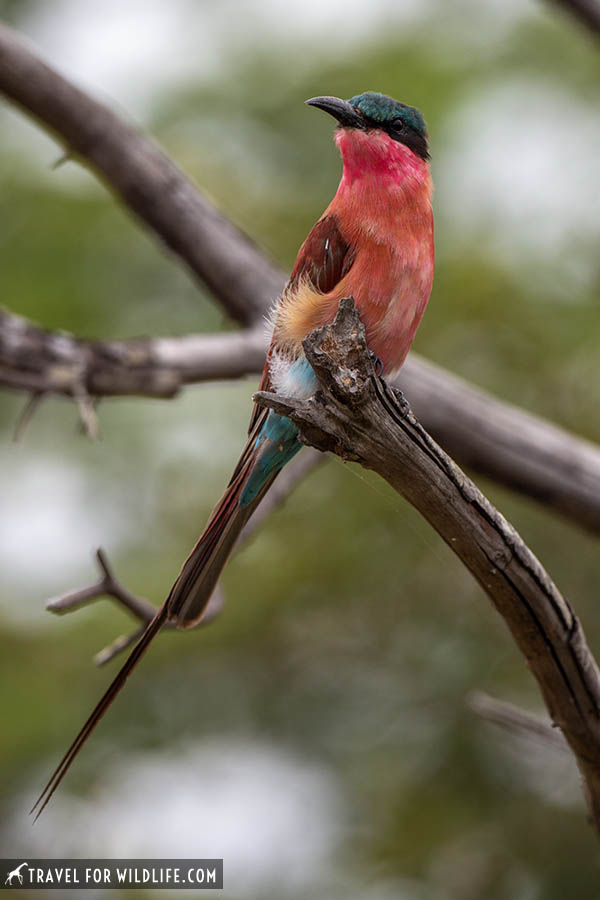
The largest African bee-eater, the Southern carmine bee-eater (Merops nubicoides) is a migrant and can be seen in Kruger Park from August/September until March/April.
These bee-eaters breed in big colonies on riverbanks.
White-fronted Bee-eater
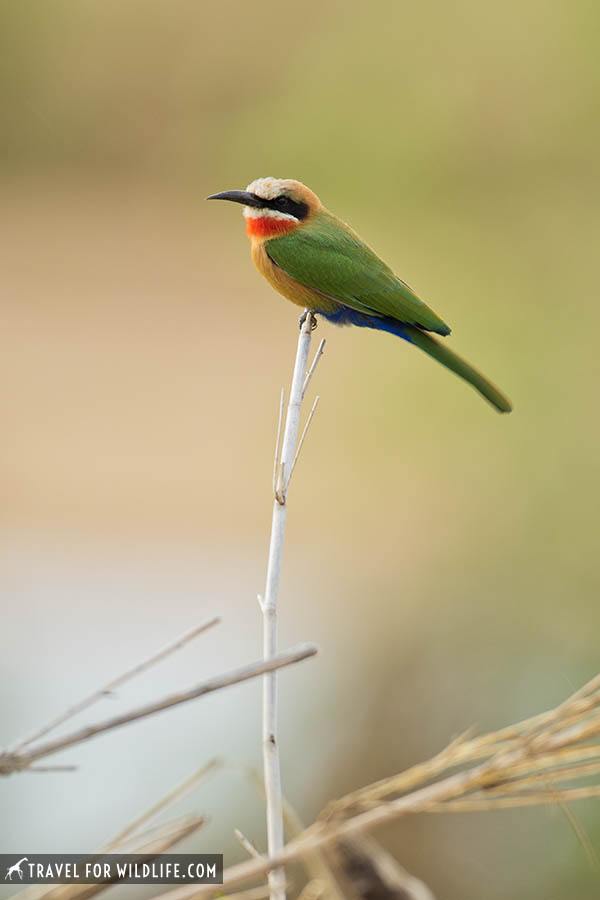
The white-fronted bee-eater (Merops bullockoides) is a common resident of Kruger National Park and found along river banks in dry woodland.
Hornbills
There are six hornbill species in South Africa, and all of them can be found in Kruger.
These arboreal or semi-terrestrial birds are large (the Southern ground hornbill is huge) and have an omnivorous diet.
Their large bills are very distinct, with a maxillary casque (larger in males), and even though these look pretty solid, their bills are light and honey-combed with air pockets.
Hornbills are monogamous and they nest in tree and rock cavities. When nesting, the female closes herself up in the nest by blocking it except for a narrow hole that the male uses to feed her through. She will stay in it for about 2.5 months. This behavior ensures the chicks are fully protected against predators.
Southern ground hornbill
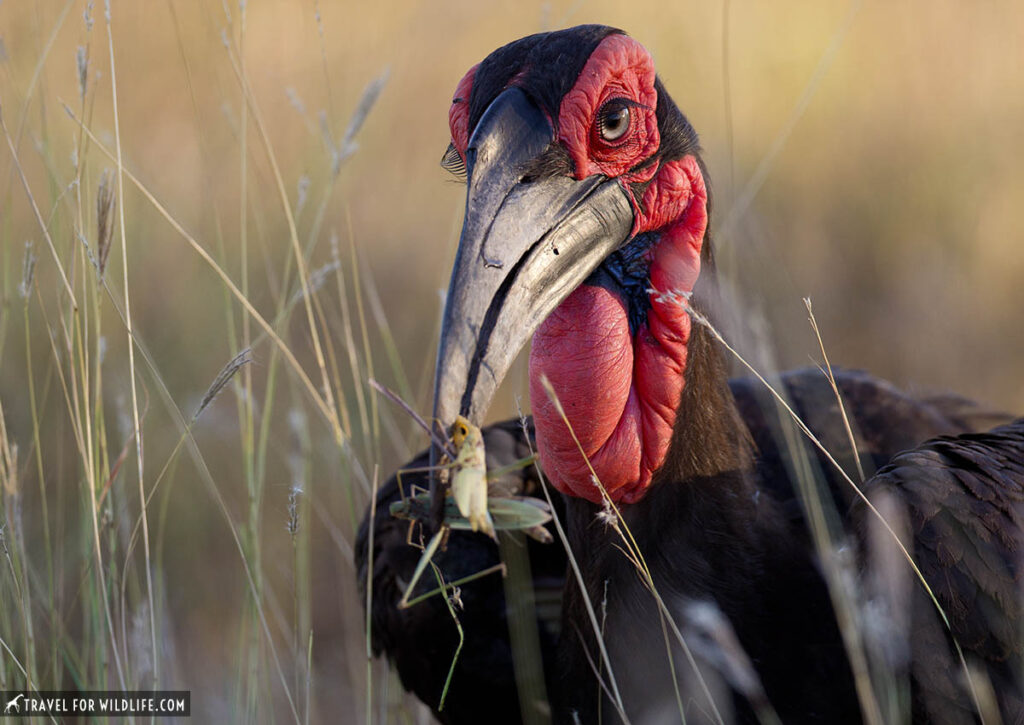
The largest of the South African hornbills, the Southern hornbill (Bucorvus leadbeareti) is an endangered bird and any encounter with these incredible animals is memorable.
You can see them walking around the savanna in small groups. We saw the individual in the photo with another adult and a juvenile (juveniles have yellow markings instead of red). We observed them for a while as they were foraging for insects. Once they had found one, they would carry it around (as in the photo) as if they were very proud of their find.
Southern red-billed hornbill
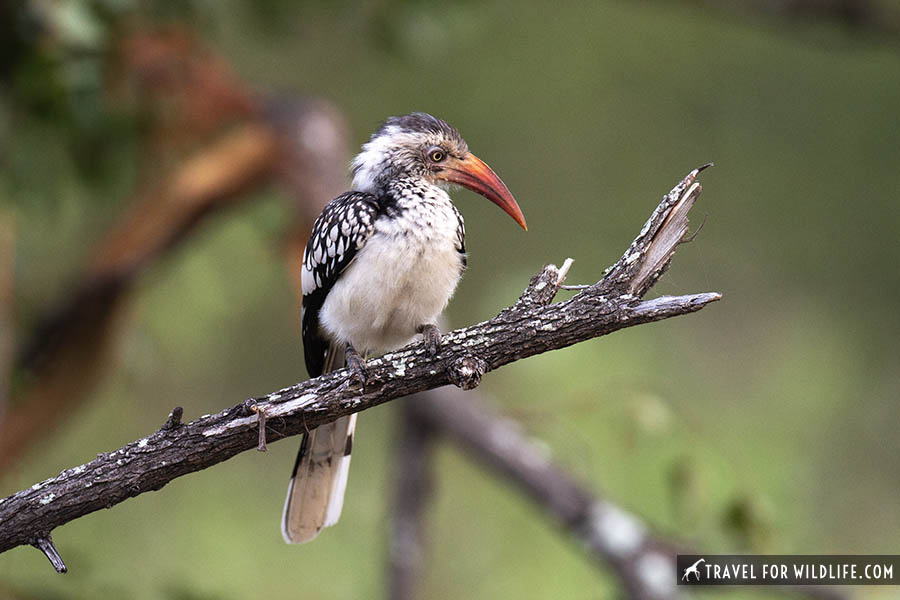
The Southern red-billed hornbill (Tockus erythrorhunchus) is a medium hornbill that can be distinguished by its yellow eyes, red beak, and a black patch in its lower mandible.
Southern Yellow-billed Hornbill
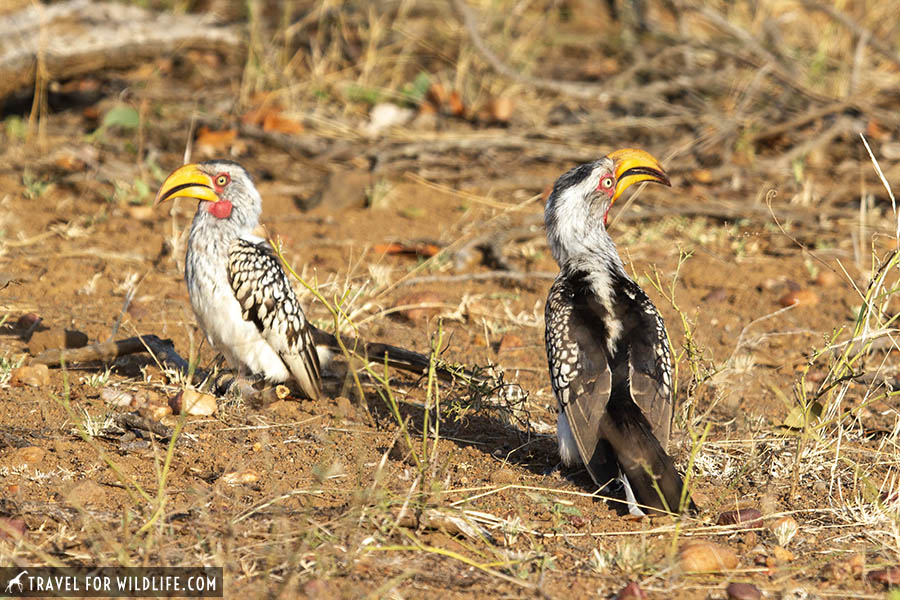
With a range similar to that of the African grey hornbill, the Southern yellow-billed hornbill (Tockus leucomelas) is a very curious bird and it is very entertaining to watch.
During one of our visits to the Kgalagadi Transfontier National Park, we were staying at a cabin at Urikaruus Wilderness Camp when a tap on the window glass woke us up. There were two southern yellow-billed hornbills ‘knocking’ at our window! We suspected they saw their own reflection in the glass and weren’t amused by it!
Whenever we see these hornbills, we try and follow them for a while as they like to investigate everything and they entertain us for hours.
African grey hornbill
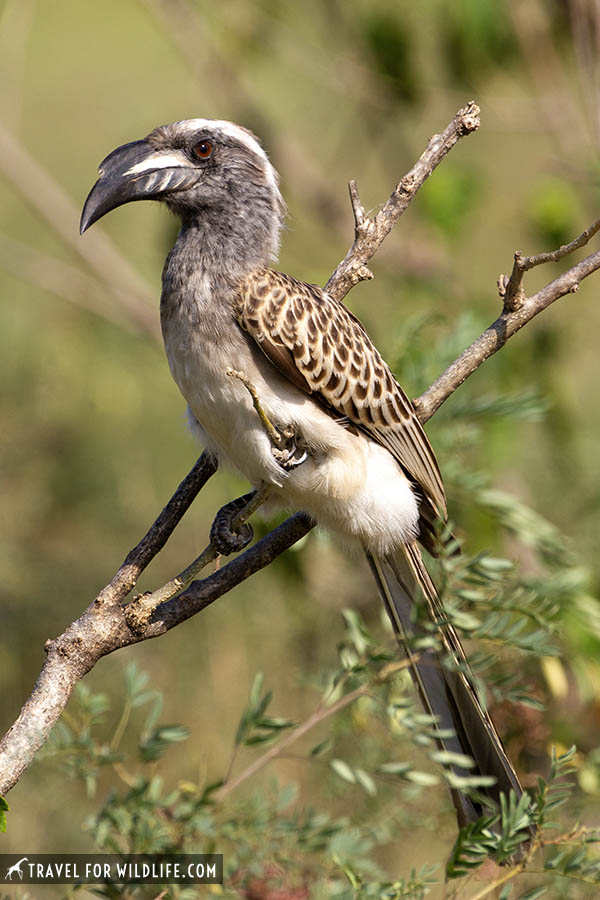
With a range very similar to that of Southern yellow hornbills, the African grey hornbill (Lophoceros nasutus) is distinguishable from other hornbills by the white markings in the lower mandible.
Crowned hornbill
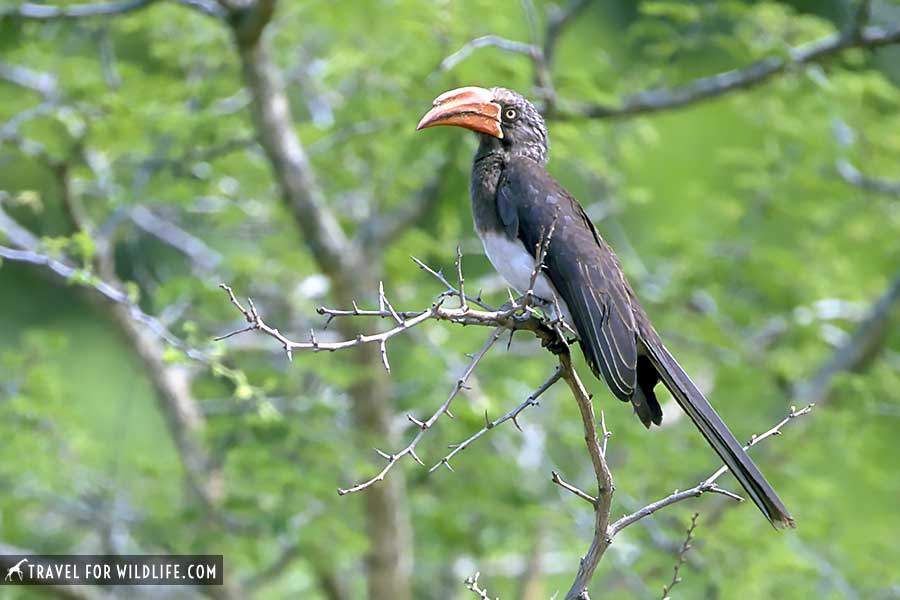
Found in woodlands the Crowned hornbill (Lophoceros alboterminatus) has dark brown plumage, a white belly, it’s the only hornbill in Kruger that has a yellow strip at the base of its bill.
Shrikes
Magpie Shrike
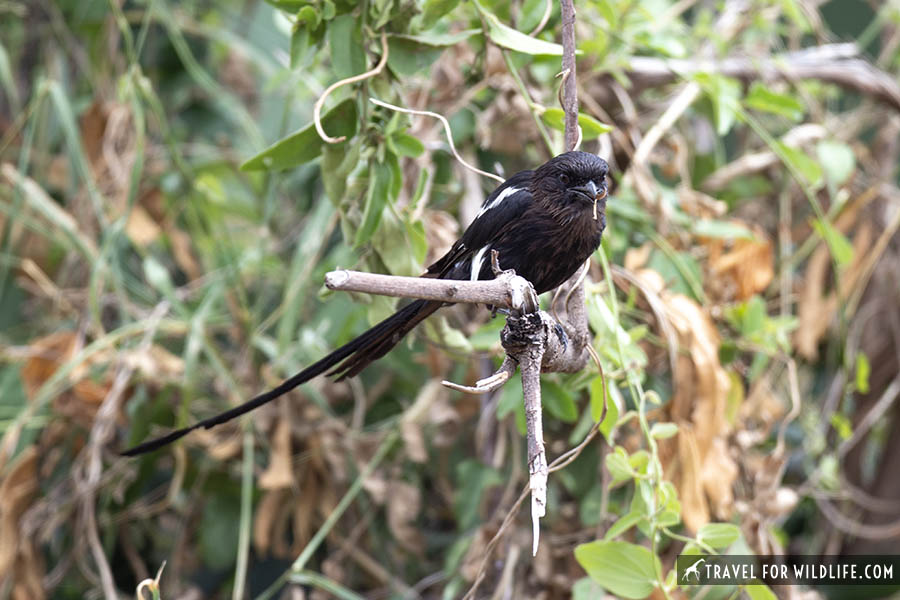
Swallows
Barn swallow
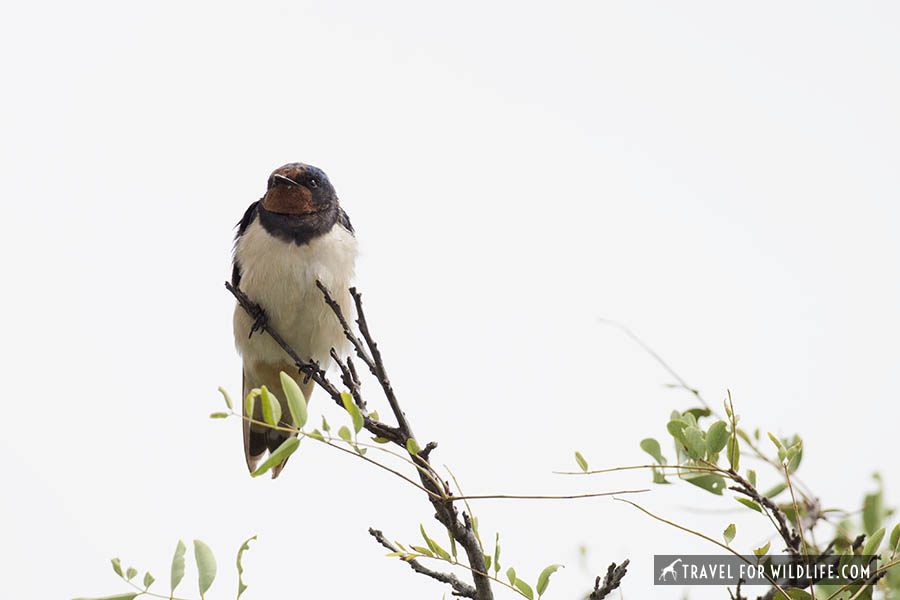
Starlings
Burchell’s starling
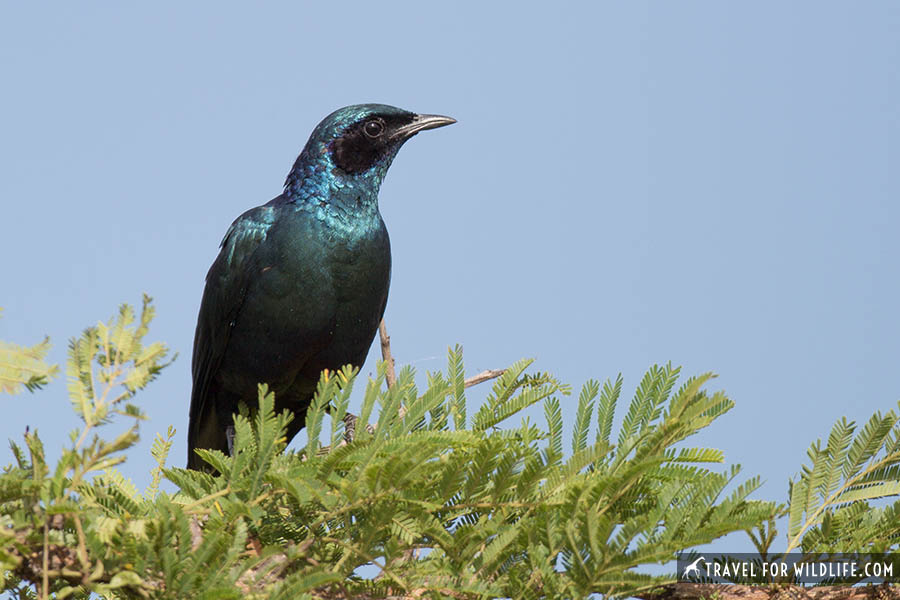
Greater Blue-eared Starling
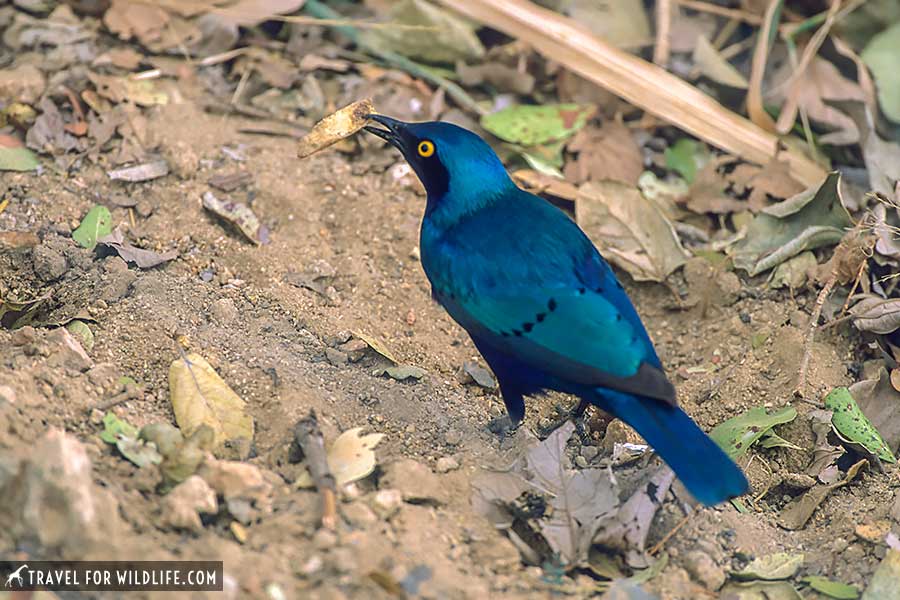
Oxpeckers
Oxpeckers are known to hang around buffalo, giraffes, and other mammals as they pluck their fur for nests in tree cavities and feed on their ticks and other ectoparasites.
Red-billed oxpeckers and Yellow-billed oxpeckers are found in Kruger and can hybridize.
Red-Billed Oxpecker
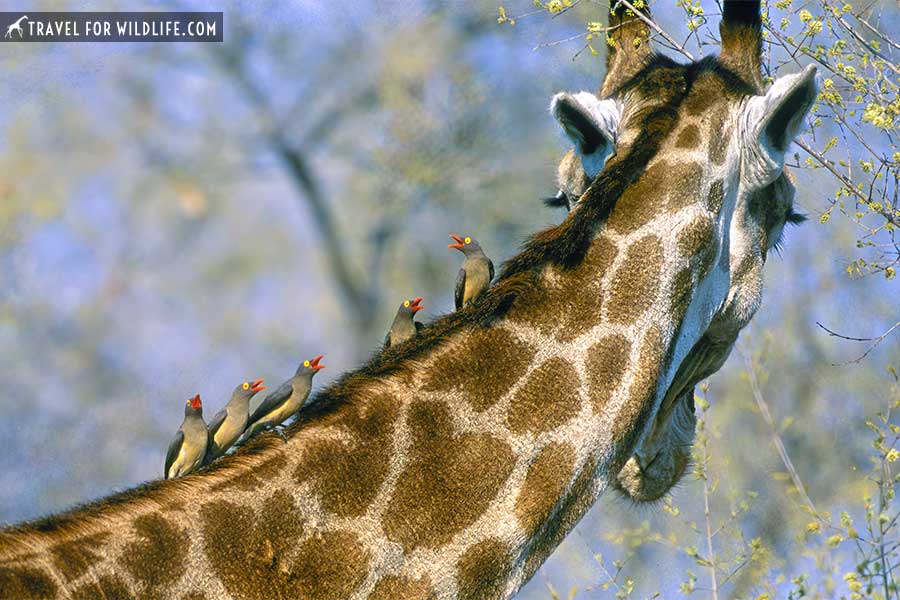
With a yellow wattle around the eye and a dark rump, the Red-billed oxpeckers are the most common in the park.
Yellow-billed oxpeckers have no yellow wattle around the red eye, and the base of their beak is yellow.
Weavers
In Kruger, you can find 8 different species of weavers: Red-headed weaver, Southern masked weaver, Village weaver, Lesser masked weaver, Thick-billed weaver, Spectacled weaver, Cape weaver, and Holub’s golden weaver.
Weavers are famous for their intricate woven nests. If you see a male starting a nest, stop and marvel at its skills!
Southern Masked Weaver
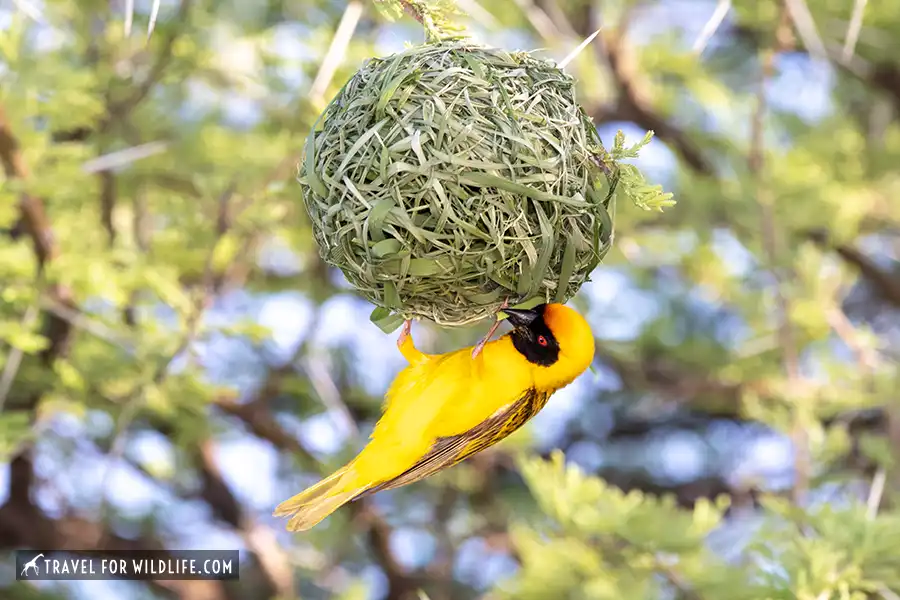
The most widespread weaver in South Africa, the Southern masked weaver can be found in the open savanna, where he favors Acacia trees. Feeds on insects, seeds, and nectar.
With red eyes, a yellow belly, and a black mask, it can be confused with the Village weaver. One way to tell them apart is to look at their fore crown. The Southern masked weaver has a black fore crown, whereas the Village weaver has a yellow fore crown.
Barbets
There are three species of Barbets in Kruger: Crested barbet, Black-collared barbet, and Acacia pied barbet.
Barbets are frugivores (feed primarily on fruits) but will also eat small insects and nectar. Barbets can be found in both forests and savanna. They are tree cavity nesters, where they’ll lay 3 to five white eggs.
Crested Barbet
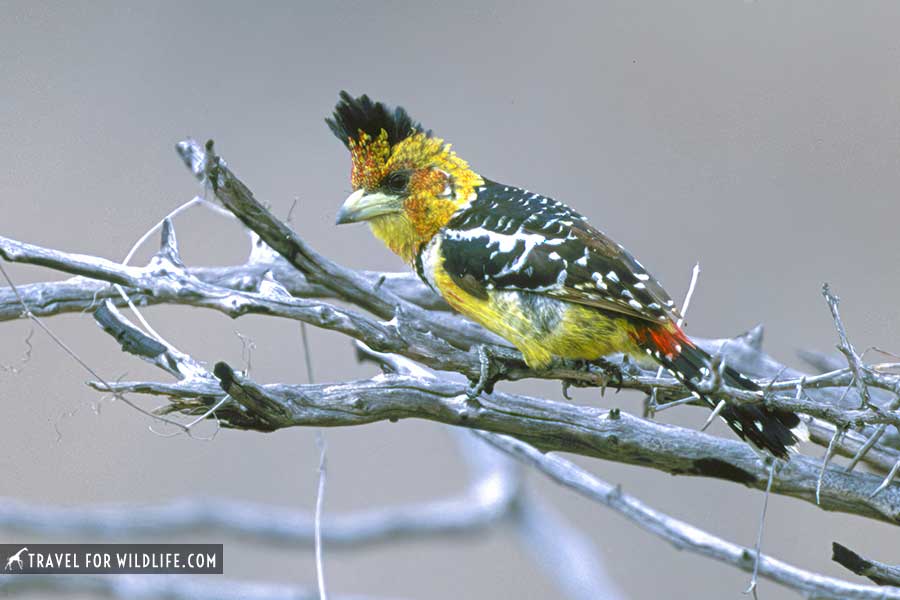
The Crested Barbet (Trachyphonus vaillantii) is a common resident in Kruger that favors dry acacia forests. Will excavate a hole on the underside of a dead stump for nesting.
Black-collared Barbet
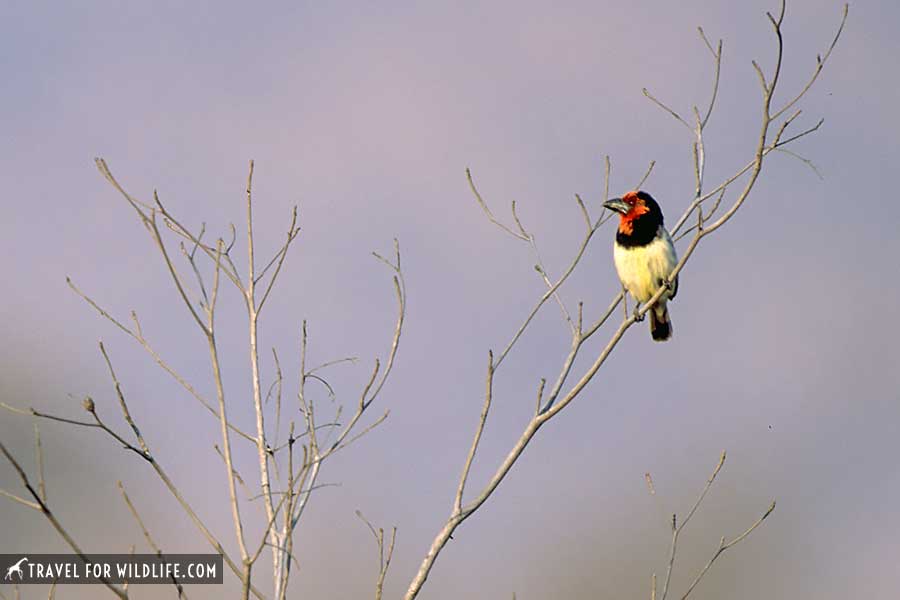
The Black-collared barbet (Lybius torquatus) is a common resident of Kruger and is often found in pairs or small flocks. They favor moist woodlands. They also excavate holes in dead stumps.
Woodpeckers
There are 6 species of woodpeckers found in Kruger: Bearded woodpecker, Bennett’s woodpecker, Golden-tailed woodpecker, Cardinal woodpecker, Olive woodpecker, and Ground woodpecker.
Bennett’s Woodpecker
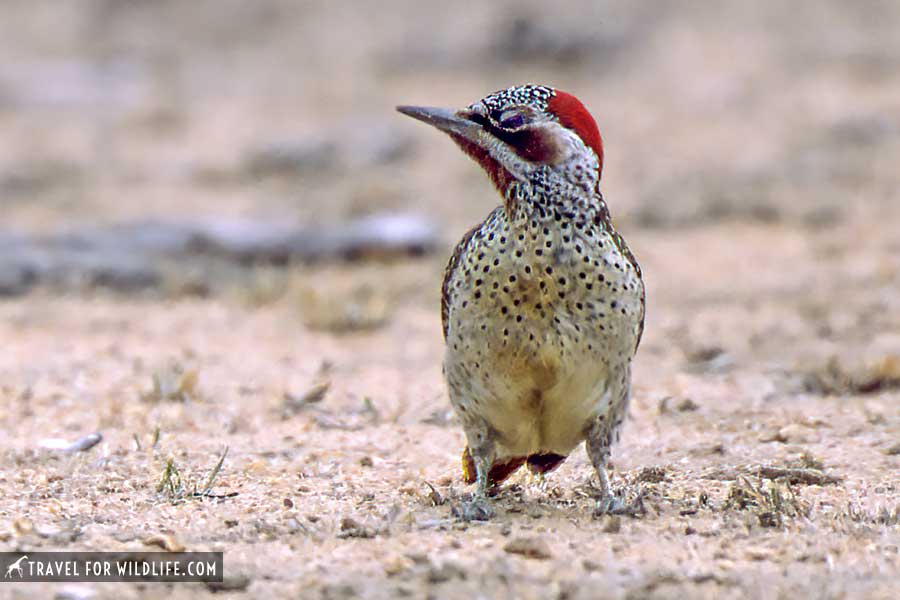
Easily identified by its brown cheeks & throat, red eyes, and speckled underparts. Their favorite foods are ants and their eggs and pupae. Found in deciduous woodlands.
It can be mistaken with Bearded woodpeckers, but an easy way to tell them apart is by looking at their underpart. The Bearded woodpecker has barred underparts while Bennett’s woodpecker’s underparts are speckled.
Orioles
Orioles are solitary passerines that favor forest canopies. There are three species of orioles found in Kruger National Park, the Black-headed oriole, the African Golden oriole, and the Eurasian Golden oriole (migrant and uncommon, only found from October to April).
Black-headed Oriole
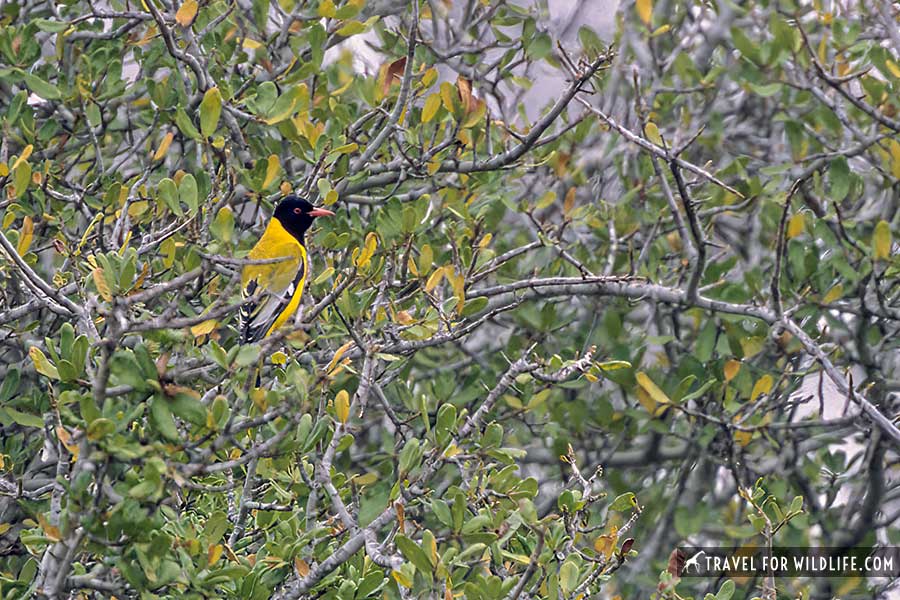
Very easy to identify, with black head and chest, yellow belly, coral beak, and greenish back. the Black-headed oriole (Oriolus larvatus) is a common resident in Kruger. Found in woodlands and savannah it feeds on insects, fruits, and nectar. If you see one with an orange forehead, look closely! It is nectar coating its face feathers.
Drongos
Fork-Tailed Drongo
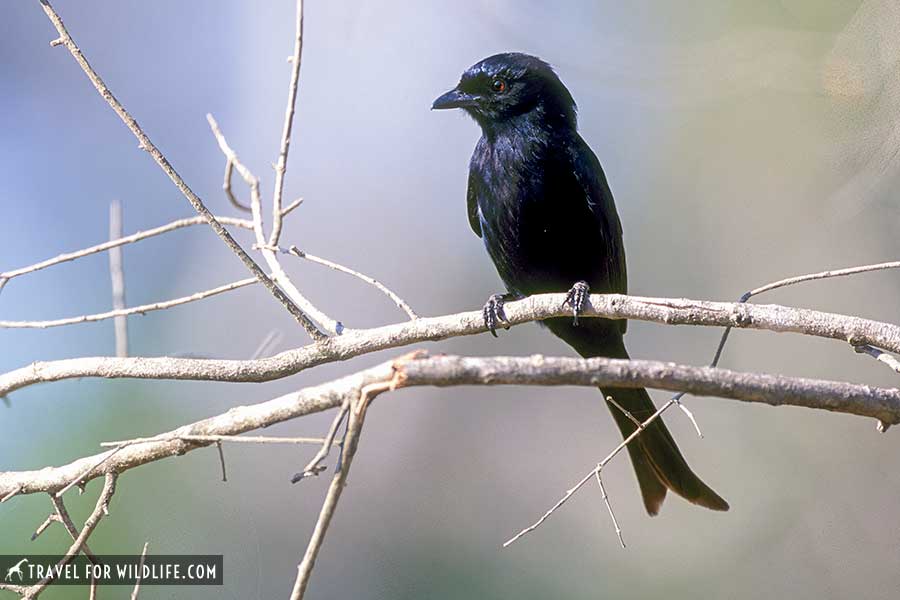
These bold birds are easily identified by their forked tail, dark color, and red eyes. During molt their tail appears to be double-forked.
Distinguishable from the Square-tailed Drongo by their more deeply forked tail.
Babblers
Both species of South African babblers are found in Kruger: the Arrow-marked Babbler and the Southern Pied Babbler.
Arrow-marked Babbler
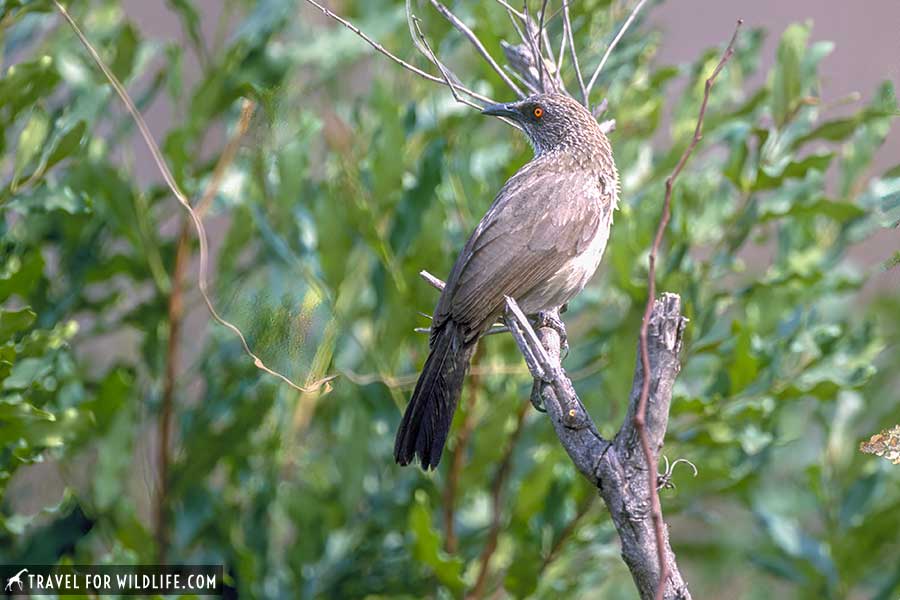
The Arrow-marked Babbler is a common bird in Kruger. Found in small groups around savannah and riparian thickets.
Queleas and Bishops
These are small to medium-sized birds and are always found in very large and sometimes mixed flocks.
Southern Red Bishop
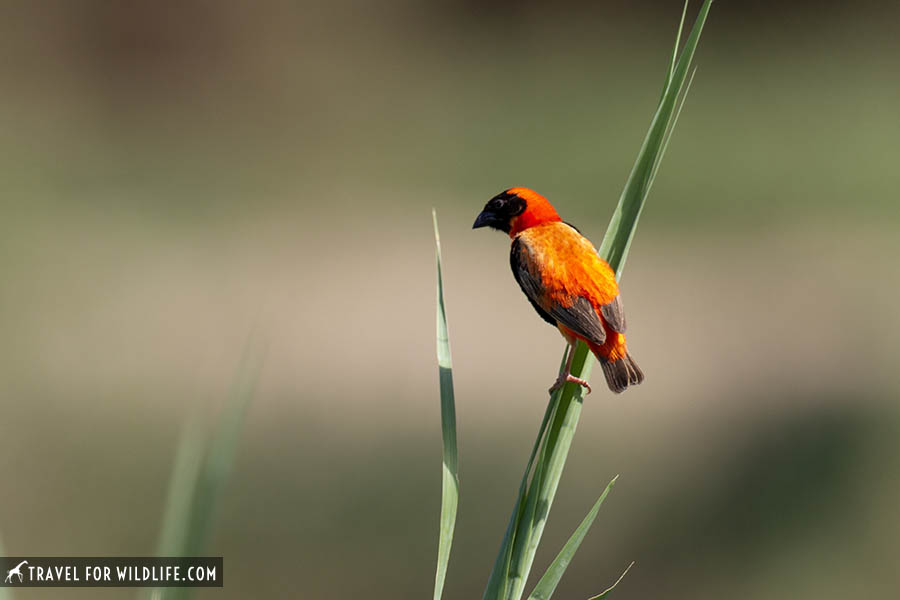
Very easy to identify by its bright red color, the Southern Red Bishop can be found along marshy grasslands and wetlands in Kruger. Distinguishable from the Black-winged Red Bishop by their black forecrown. Black-winged Red Bishop has a red forecrown.
Red-billed queleas
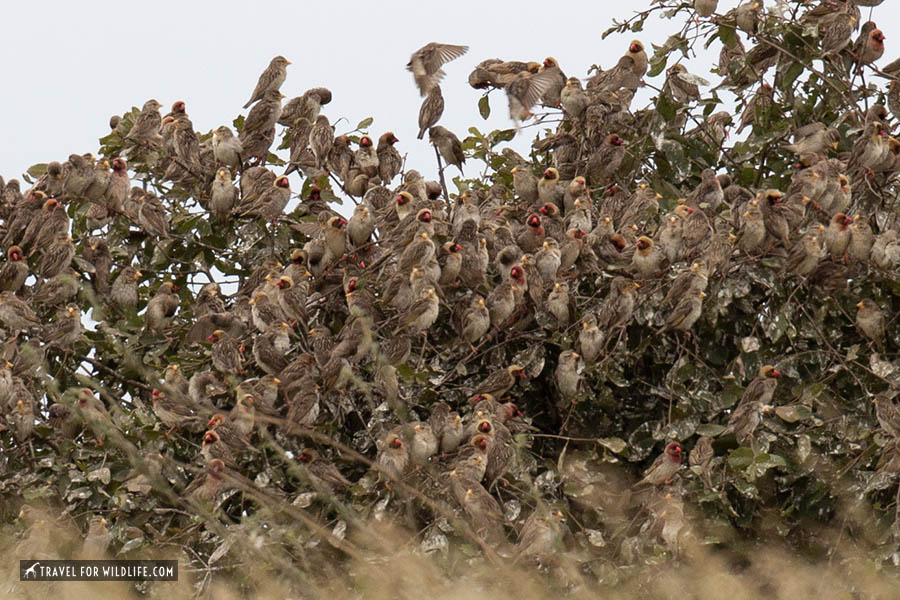
These birds have a black facial mask, a red eye ring, and a bright red bill. They are found almost everywhere in Southern Africa and are always present in very large groups.
Next time you visit Kruger National Park, make sure you have your bird guide and your binoculars. Take some time to visit the bird hides that are found around the park and listen to their calls. You might find your lifer bird!

Cristina Garcia
Zoologist and wildlife photographer. She has worked in the field with jackals, wolves, cheetahs, & leopards. She serves on the Board of Directors of SEE Turtles, a non-profit sea turtle conservation organization.
Read her posts at Travel For Wildlife and see more of her work at Truly Wild, & Our Wild Yard.

Ken
Tuesday 20th of June 2023
Amazing, although don't forget everyone's favorite travelling guide
Simon
Friday 9th of June 2023
Great article!
Damn secretary birds are hard to find. Love the ground hornbills muchly.
cristina garcia
Friday 9th of June 2023
We always have more luck around the Karoo and the Kalahari for Secretary birds. The shorter vegetation makes it easier. I love the ground hornbills so much, they are super funny to watch too.